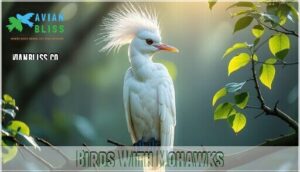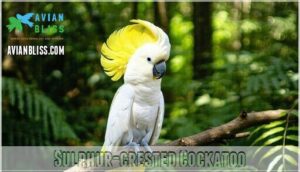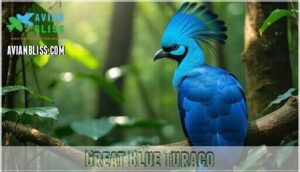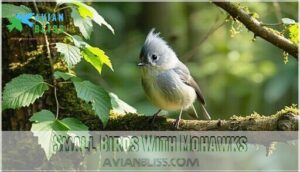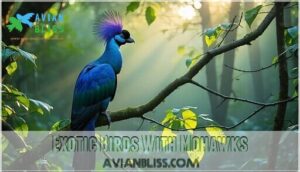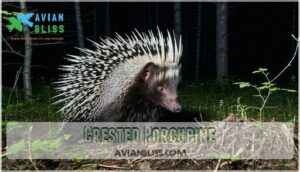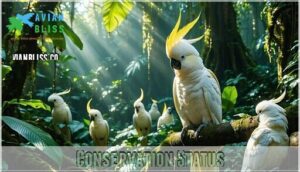This site is supported by our readers. We may earn a commission, at no cost to you, if you purchase through links.
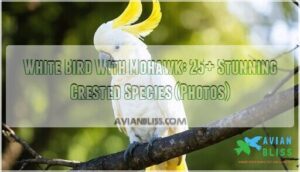 You’ve spotted a white bird with mohawk feathers that stands tall and proud like nature’s punk rocker.
You’ve spotted a white bird with mohawk feathers that stands tall and proud like nature’s punk rocker.
The Sulphur-crested Cockatoo tops this list, flaunting bright yellow crest feathers that pop up when excited or alarmed. These intelligent Australian natives aren’t just show-offs – their crests communicate emotions and intentions to other birds.
You’ll also find the elegant Umbrella Cockatoo, whose semicircular white plume opens like a fancy parasol. Both species raise and lower their distinctive headgear for courtship displays, territorial warnings, and social interactions.
These feathered rebels prove that sometimes the most striking birds break all the rules of ordinary plumage patterns, and their ability to raise and lower their distinctive headgear is a key part of their behavior.
Table Of Contents
- Key Takeaways
- Birds With Mohawks
- Notable Birds With Mohawks
- Physical Characteristics
- Small Birds With Mohawks
- Larger Birds With Mohawks
- Exotic Birds With Mohawks
- Birds With Unique Mohawks
- Conservation Status
- Threats to Birds With Mohawks
- Conservation Efforts
- Frequently Asked Questions (FAQs)
- What bird has a Mohawk?
- What does a Mohawk bird look like?
- Why do some birds use Mohawks?
- What makes a Smew a Mohawk bird?
- Which cockatoo has a big Mohawk?
- Where do mohawked birds live?
- Where Do Royal Flycatchers Live?
- What Is The Bird With A Yellow Mohawk?
- What Bird Has An Orange Mohawk?
- What are the white birds with a mohawk?
- Conclusion
Key Takeaways
- You’ll recognize white birds with mohawks primarily by the Sulphur-crested Cockatoo’s bright yellow crest and the Umbrella Cockatoo’s semicircular white plume that opens like a fancy parasol when they’re excited or alarmed.
- You can observe these crested birds using their mohawks as sophisticated communication tools to express emotions, establish territory, attract mates, and signal danger to other birds through precise crest positioning and movement.
- You’ll find these intelligent birds face serious conservation threats from habitat destruction, illegal pet trade, and human encroachment, making protective efforts essential for species like the critically endangered Philippine Eagle and near-threatened Victoria Crowned Pigeon.
- You can support conservation by choosing ethical pet ownership, participating in citizen science projects, supporting habitat preservation programs, and avoiding purchases from illegal wildlife trade networks.
Birds With Mohawks
You’ll find that crested birds use their distinctive mohawk-like feathers for essential communication tasks, including attracting mates, establishing territory, and signaling their emotions to other birds.
These specialized head crests serve as nature’s communication system, allowing species like cockatoos, cardinals, and crowned pigeons to express aggression, courtship interest, or alarm through precise crest positioning and movement, which is a key aspect of their communication.
Nature’s mohawks aren’t just for show—they’re sophisticated feathered telegraphs broadcasting every emotion and intention.
Communication
When observing crested birds, you’ll discover their mohawks serve as sophisticated communication tools beyond mere decoration.
These white birds with mohawks use crest displays to express emotions, establish social hierarchies, and coordinate group behaviors. Bird communication involves complex avian behavior patterns that researchers continue studying.
Crested birds employ multiple communication methods:
- Crest displays: Raised crests signal alertness or aggression, while flattened crests indicate submission
- Vocalizations: Calls accompany crest movements to reinforce messages
- Body language: Wing positions and tail movements complement crest signals
- Tactile communication: Physical contact reinforces social bonds
- Chemical signals: Scent markers provide additional information
Understanding these patterns helps you interpret what your feathered friends are really saying.
Courtship
When you’re watching crested birds during mating season, their mohawk signaling becomes pure theater.
Males lift and fan their feathers dramatically, creating stunning crest displays that catch females’ attention.
Plumage variations help distinguish strong mates from weak ones.
Female selection often depends on these impressive mating rituals – your white bird with mohawk transforms into nature’s ultimate showoff during courtship.
Territorial Disputes
When you spot crested birds defending their turf, you’ll witness nature’s most dramatic showdowns.
Crest displays signal ownership while vocalizations warn intruders.
Bird territories become battlegrounds where dispute escalation leads to physical combat.
Species like Pileated Woodpeckers and Steller’s Jays use bird aggression tactics, raising their mohawks during bird fights.
Resource defense in bird habitats determines survival, making territorial bird behavior absolutely essential.
Defense Mechanisms
When danger strikes, crested birds transform their mohawks into survival tools.
Nature’s feathered warriors unleash their mohawks as shields against predators—a stunning display of evolutionary survival artistry.
You’ll witness fascinating threat response behaviors as these feathered fighters employ multiple defense strategies:
- Crest display intimidation – Raising feathers to appear larger and more menacing
- Camouflage crest positioning – Flattening crests to blend seamlessly with surroundings
- Predator evasion signaling – Quick movements alerting flockmates to incoming threats
- Mimicry defense tactics – Resembling dangerous species through strategic crest positioning
Species Recognition
You can identify white bird with mohawk species through distinct crest identification markers.
Sulphurcrested Cockatoo displays bright yellow crown feathers, while other bird species show unique plumage variations.
Behavioral cues like crest positioning help distinguish between similar bird with crest types.
Vocalizations and habitat specifics provide additional clues for accurate bird identification in the field.
Notable Birds With Mohawks
You’ll discover some of the world’s most recognizable crested birds, including species that showcase dramatic mohawk-style feathers for communication and mating displays.
These notable birds range from the striking Sulphur-crested Cockatoo with its bright yellow crest to the elegant Grey Crowned Crane, each using their distinctive head feathers for different behavioral purposes, including communication.
Grey Crowned Crane
Why does the Grey Crowned Crane captivate birdwatchers worldwide? This majestic bird species showcases golden crown feathers and distinctive bird characteristics that make it unforgettable.
Conservation Challenges threaten their Habitat Needs across African wetlands, while their elaborate Mating Rituals include synchronized dancing.
Key Crane Behavior patterns include:
- Complex courtship dances during breeding season
- Omnivorous Diet Analysis featuring insects and seeds
- Strong territorial displays protecting nesting sites
Northern Cardinal
Cardinal Behavior in your backyard reveals fascinating Regional Variations across North America.
While not a white bird with mohawk, the Northern Cardinal sports a striking triangular crest that signals mood and territory.
Plumage Differences between scarlet males and coral-tinged females showcase nature’s artistry.
Their mohawk serves Backyard Attraction through seed offerings, making these crested beauties symbols of hope and renewal in Cardinal Symbolism.
Their crests also aid in communication among flock.
Sulphur-crested Cockatoo
You’ll spot the sulphurcrested cockatoo’s magnificent yellow crest from Australia’s rainforests, where these white cockatoo beauties showcase their mohawks during elaborate Mating Rituals.
Their crests serve multiple functions in Vocal Communication and territorial displays, while Captive Care requires understanding their Moluccan Origins intelligence.
Many owners find specialized cockatoo products helpful for their care.
- Crest Functionality: Expresses emotions and dominance
- Mating displays: Fan-shaped courtship presentations
- Social intelligence: Complex communication through crest positioning
Great Blue Turaco
You’ll find the Great Blue Turaco showcasing stunning sapphire feathers and distinctive crests in African rainforests.
This white bird with mohawk relatives displays fascinating Turaco Behavior while foraging fruits in their Great Blue Habitat.
Their mohawks communicate emotions effectively.
Turaco Diet consists mainly of berries and leaves.
Turaco Conservation efforts protect these magnificent birds, though they’re distinct from Purplecrested Turaco species in Turaco Taxonomy classifications.
Western Crowned Pigeon
Western Crowned Pigeons showcase stunning grayish head feathers and lacy crests that’ll take your breath away. These exotic birds face serious habitat destruction, making conservation urgency critical.
You’ll find these white bird with mohawk relatives in New Guinea’s forests, where captive breeding programs offer hope.
- Their majestic crests shimmer like living crowns in dappled sunlight
- Each pigeon’s mohawk tells a story of millions of years of evolution
- Their vulnerable status means future generations might only see them in photos, which is a critical concern for their preservation.
Physical Characteristics
You’ll notice that crested birds display remarkable variation in their mohawk features, from the tall, pointed crests of cockatoos to the fan-shaped plumes of crowned pigeons.
These distinctive head feathers vary substantially in shape, color, and size across different species, with some crests matching the bird’s overall plumage while others create striking contrasts that serve important biological functions, including the display of biological functions.
Crest Shape
You’ll notice crests come in fascinating shapes that serve distinct purposes.
Pointed crests like those on cardinals pierce the air during flight, while rounded crests on titmice create softer silhouettes.
Fan-shaped crests spread wide for dramatic displays, and shaggy crests appear deliberately messy.
Crest stiffness varies too—some feathers stand rigid, others flow gently.
Each white bird with mohawk sports unique crest shape variations.
Crest Color
Crest color variation among birds creates nature’s most stunning displays.
You’ll discover that pigment sources determine whether a white bird with mohawk sports brilliant reds, deep blues, or subtle grays.
These vibrant crests serve multiple purposes:
- Mate attraction – Bright colors signal health and genetic fitness
- Species identification – Unique hues help birds recognize their own kind
- Camouflage function – Some feathers blend with surroundings for protection
To aid in identification, consider plumage color variations among different species.
Crest Size
Beyond color variations, crest size dramatically differs across species.
You’ll notice the sulphur-crested cockatoo’s massive mohawk dwarfs a tufted titmouse’s petite tuft.
Size variation reflects evolutionary factors – larger crests enhance display significance during mating rituals, while smaller ones suit forest navigation.
Species comparison reveals how crest function shapes bird morphology, with each white bird with mohawk perfectly adapted.
Small Birds With Mohawks
You’ll find some of nature’s most charming crested birds among smaller species that frequent backyards and forests across North America.
These compact birds, including the gray-crested Tufted Titmouse and the striking Pileated Woodpecker, use their distinctive head feathers for communication and attracting mates during breeding season.
Tufted Titmouse
The Tufted Titmouse, a small North American songbird, flaunts a gray back and a charming mohawk-like crest.
Found in wooded areas, it’s known for bold Titmouse behavior, often visiting feeders for seeds.
Its whimsical calls brighten mornings, while its nesting habits include using tree cavities.
These crests make them a backyard attraction, adding life to any landscape.
Many enthusiasts purchase a specialized Titmouse feeder to attract these birds.
Pileated Woodpecker
North America’s largest woodpecker commands attention with its striking red mohawk-style crest.
You’ll spot this impressive bird in mature forests where it demonstrates remarkable foraging behavior, hammering dead trees for carpenter ants.
Its drumming communication echoes through woodlands, while nesting habits involve excavating rectangular cavities.
Despite stable conservation status, habitat needs require old-growth forests for ideal survival, making bird watching and bird photography rewarding experiences.
Find pileated woodpecker photos online for purchase.
- Habitat Needs: Mature deciduous and mixed forests
- Foraging Behavior: Carpenter ants and wood-boring beetles
- Drumming Communication: Territorial calls and mate attraction
- Nesting Habits: Deep rectangular tree cavities
Steller’s Jay
You’ll spot Stellers Jay’s magnificent dark blue mohawk across North America’s coniferous forests.
This intelligent bird’s crest mobility signals emotions during social behavior interactions.
Their loud vocalizations echo through Stellers habitat while they forage for diverse foods.
These adaptable crests help with communication and territory defense, making them essential for any bird identification guide covering western North America.
Cedar Waxwing
Cedar Waxwings sport sleek, tawny brown crests that look "slicked back" against their heads.
These North American nomads roam in flocks, following fruit supplies across continents. You’ll spot their distinctive feathers and Social Behavior in berry-laden trees during winter months.
- Waxwing Diet: Primarily berries from cedar, cherry, and mountain ash trees
- Migration Patterns: Follow food sources rather than fixed seasonal routes
- Habitat Preference: Woodlands, orchards, and fruit-producing suburban areas
Larger Birds With Mohawks
When you spot larger crested birds in the wild, you’ll notice their mohawks serve as powerful communication tools that can be raised or lowered depending on their mood and circumstances.
These impressive species, including the Wood Duck’s iridescent crest and the Eurasian Hoopoe’s fan-shaped crown, use their distinctive head feathers for attracting mates and establishing territory boundaries, which is a crucial aspect of their social behavior.
Great Crested Flycatcher
Looking beyond smaller crested species, you’ll encounter the Great Crested Flycatcher, a striking white bird with mohawk-style plumage.
This species showcases unique Nesting Habits, building homes in tree cavities.
Their Flycatcher Diet consists primarily of insects caught mid-flight.
Vocalizations include distinctive "wheep" calls echoing through Habitat Preference areas like mature forests.
Migration Patterns guide them from breeding grounds to wintering territories, making them essential subjects in bird identification guides focusing on bird crests.
Cockatiel
Meet the Cockatiel—your charming feathered friend with a communicating crest that reveals every mood.
These beloved pet birds sport gray plumage with striking orange cheek patches, making them perfect mohawk companions.
- Cockatiel mutations: Explore Pearl, Lutino, and Pied varieties for unique coloring
- Cockatiel behavior: Watch their crest positions indicate excitement or calm
- Cockatiel diet: Provide pellets, seeds, and fresh vegetables daily
- Cockatiel care: Make certain spacious cages with regular social interaction
Pyrrhuloxia
You’ll recognize the Pyrrhuloxia by its shaggy gray-and-red mohawk that perfectly matches its desert lifestyle.
This southwestern species showcases remarkable Desert Adaptation through its specialized Pyrrhuloxia Diet of seeds and cactus fruits.
The bird’s Plumage Variation includes subtle red crests in males, while females display muted feathers.
Their Conservation Status remains stable across their Southwestern Habitat range.
Wood Duck
Wood Duck males sport a striking mohawk-like crest that shimmers with iridescent plumage in sunlight.
You’ll find these stunning waterfowl in wooded swamps and freshwater marshes across North America.
Their unique nesting habits involve tree cavities, making habitat preference essential for duckling development.
- Brilliant green and purple head feathers catch every ray of light
- Distinctive white chin stripe creates perfect contrast against dark feathers
- Males’ elaborate crest rises dramatically during courtship displays
- Chestnut breast feathers blend seamlessly with darker wing patterns
- Their piercing red eyes seem to glow against metallic bird traits, showcasing their iridescent plumage and striking appearance.
Eurasian Hoopoe
You’ll recognize the Eurasian Hoopoe by its magnificent cinnamon crest edged in black—a true mohawk masterpiece.
This globally distributed bird raises its striking crown during territorial disputes and courtship displays.
Found across Europe, Asia, and Africa, it prefers open woodlands and grasslands where it forages for insects.
Its unique breeding behavior includes nesting in tree cavities.
Exotic Birds With Mohawks
You’ll discover some of the world’s most spectacular crested birds from distant continents, including the Victoria Crowned Pigeon with its lacy blue mohawk and the Purple-crested Turaco’s royal indigo feathers.
These exotic species showcase how evolution has shaped stunning crest designs across different habitats, from New Guinea’s rainforests to Africa’s woodlands.
Victoria Crowned Pigeon
The Victoria Crowned Pigeon from New Guinea Native forests displays stunning Mohawk Appearance with its elaborate blue lace-like crest.
Named after Queen Victoria, you’ll find these magnificent birds in lowland swamps where their Pigeon Diet includes fruits and seeds.
Captive Breeding programs help preserve this spectacular white bird species.
- Intricate blue lace-like feathers forming a delicate crown
- Regal bearing that inspired its royal namesake
- Distinctive maroon chest contrasting with bluish-gray plumage
- Impressive size making them ideal subjects for bird photography
- Graceful courtship displays with tail fanning and body rocking
Red-whiskered Bulbul
Beyond Victoria’s regal charm, you’ll spot the Red-whiskered Bulbul’s striking black mohawk contrasting against its white cheeks.
This songbird’s distinctive red face patch makes bird identification simple.
These feathers create quite the spectacle in gardens and parks.
| Bulbul Habitat | Bulbul Diet | Bulbul Behavior |
|---|---|---|
| Urban gardens | Fruits, nectar | Social flocking |
| Forest edges | Small insects | Melodic singing |
| Agricultural areas | Flower buds | Territory defense |
| Suburban parks | Plant matter | Nest building |
Bulbul Conservation efforts focus on Bulbul Taxonomy research, protecting these birds with mohawks from habitat loss while maintaining their stable populations across Asia.
Golden Pheasant
You’ll find the Golden Pheasant showcasing nature’s most spectacular mohawks with its brilliant golden crest and fiery plumage.
This Chinese Origins species displays remarkable feathers during courtship rituals.
- Habitat Preferences: Dense woodlands and mountainous regions
- Display Behavior: Males fan crests to attract mates
- Captive Breeding: Widely bred for conservation efforts
- Mutation Colors: Various color variations exist in captivity
Crested Tit
You’ll spot the Crested Tit in Scotland’s ancient pine forests, where its spiky salt-and-pepper crest makes bird identification easy.
This acrobatic little charmer displays fascinating Crested Tit behavior while foraging for insects and seeds in treetops.
The related bridled titmouse habitat consists of oak and pine-oak woodlands in the southwestern United States.
Their stable breeding habits and specific habitat preferences for old-growth conifers raise conservation concerns as suitable forests disappear across Europe.
Purple-crested Turaco
You’ll spot the Purple-crested Turaco’s royal blue and indigo mohawk across sub-Saharan Africa.
This white-crested turaco displays brilliant crest coloration that shifts with sunlight.
African Turacos like this species showcase remarkable social behavior in small flocks.
Their white bird status comes from pale undertail feathers contrasting their vibrant plumage.
- Diet consists primarily of fruits, leaves, and flowers from forest canopy
- Conservation needs include protecting remaining woodland habitats from deforestation
- Social behavior involves loud, distinctive calls that echo through territories
- Feathers contain unique copper-based pigments creating their stunning appearance
Birds With Unique Mohawks
You’ll encounter some birds with mohawks that stand out from typical crested species due to their unusual feather patterns and distinctive shapes.
The Smew displays a striking white-and-black mohawk that creates a "cracked ice" appearance, while other unique crested birds showcase mohawks with irregular textures, multiple colors, or asymmetrical designs that make them instantly recognizable in the wild.
Smew
You’ll recognize the Smew by its distinctive white bird appearance and shaggy mohawk-like feathers.
This small diving duck’s Smew Plumage creates a stunning "cracked ice" pattern against winter waters.
Smew Behavior includes skillful diving for fish, while their Smew Habitat spans northern European lakes.
Some white birds, like the Great Egret, also display remarkable breeding behavior.
Unfortunately, Smew Conservation efforts are needed as populations decline across their range.
Crested Porcupine
Although crested porcupines aren’t birds with mohawks, their distinctive quill display creates a striking crest resembling white bird feathers.
These nocturnal mammals inhabit Africa and parts of Europe, facing conservation challenges from habitat loss.
Their unique Defense Mechanisms and Physical Characteristics make them fascinating subjects when discussing crested creatures.
- Quill defense system – raises spiky crest when threatened
- Nocturnal foraging habits – active during nighttime hours
- Herbivorous diet – feeds on roots, bark, and vegetation
Conservation Status
Conservation efforts tell a mixed story for mohawked birds worldwide. You’ll find encouraging Conservation Successes with species like the Northern Cardinal and Tufted Titmouse maintaining stable Population Trends.
However, the white cockatoo and sulphurcrested cockatoo face varying pressures across their ranges.
| Conservation Status | Species Examples | Primary Threats |
|---|---|---|
| Critically Endangered | Philippine Eagle | Habitat loss, pollution |
| Near Threatened | Victoria Crowned Pigeon, Palm Cockatoo | Logging, wildlife trade |
| Vulnerable | Great Curassow, Crested Partridge | Hunting, range restriction |
| Least Concern | Steller’s Jay, Cedar Waxwing | Minimal current threats |
Habitat Preservation remains essential for Endangered Species survival. The Future Outlook depends heavily on continued protection efforts, especially for tropical forest dwellers facing deforestation pressures.
Threats to Birds With Mohawks
You’ll find that crested birds face serious challenges from habitat destruction, illegal hunting, and the exotic pet trade that threatens their survival worldwide.
These magnificent species, from cockatoos to crowned pigeons, struggle against human encroachment and range restrictions that limit their ability to thrive in their natural environments, facing serious challenges such as illegal hunting.
Habitat Loss
You’ll find white bird species with mohawk crests facing severe habitat loss threats.
Deforestation destroys their forest homes, while agricultural expansion eliminates nesting sites. Urbanization effects fragment remaining habitats, and climate change alters ecosystems they depend on.
Pollution threats contaminate food sources. These deforestation impacts make survival challenging, requiring urgent conservation efforts to protect these stunning crested species.
These crests, officially termed avian crests, serve essential communication functions.
Illegal Hunting
Poachers target every white bird with mohawk crests for the illegal pet trade, creating devastating poaching impacts across species.
Wildlife trade networks exploit weak hunting regulations and enforcement challenges along established trade routes.
You’ll find that effective conservation solutions require strengthened laws, increased patrol funding, and international cooperation.
Without immediate conservation efforts, these magnificent crested species face extinction from relentless hunting pressure.
Range Restriction
Range restriction traps crested birds like white cockatoos in shrinking pockets of habitat.
Island endemism makes species vulnerable when climate change and habitat fragmentation isolate populations.
Indonesia’s sulphur-crested cockatoos can’t adapt their migration patterns when introduced species compete for resources.
Australia’s mohawk-sporting birds face similar challenges.
You’ll find these magnificent creatures struggling as their world gets smaller daily.
Human Encroachment
You’re witnessing unprecedented Human Encroachment threatening white cockatoo and sulphurcrested cockatoo populations.
Their mohawk-crowned heads now face shrinking territories as civilization expands relentlessly.
- Habitat Fragmentation splits continuous forests into isolated patches
- Urban Expansion eliminates nesting sites for crested species
- Agricultural Impact reduces food sources through monoculture farming
- Deforestation Effects destroy roosting trees permanently
- Pollution Threats contaminate water sources and prey
Human activities fragment habitat faster than these magnificent birds can adapt.
Pet Trade
Human activities aren’t the only threat these magnificent birds face.
The pet trade creates devastating impacts on wild populations of crested species. You’ll find that capturing birds like the sulphur-crested cockatoo for profit decimates natural communities.
- Ethical sourcing prevents wild capture exploitation
- Captive breeding reduces pressure on wild populations
- Pet welfare standards protect individual birds
- Trade regulations control international commerce
- Conservation impact assessments guide policy decisions
Conservation Efforts
You can support crested bird conservation through habitat protection programs, anti-poaching measures, and captive breeding initiatives that help maintain stable populations.
Scientists work with local communities to create sustainable practices and educational programs that raise awareness about these remarkable species and their ecological importance.
Habitat Protection
After addressing illegal hunting, protecting natural environments becomes the backbone of bird conservation. Every white bird with mohawk depends on intact ecosystems for survival.
Forest Conservation, Wetland Preservation, and Grassland Protection create safe havens where these crested species flourish.
| Conservation Type | Benefit | Example Species |
|---|---|---|
| Forest Conservation | Nesting sites | Pileated Woodpecker |
| Wetland Preservation | Food sources | Wood Duck |
| Grassland Protection | Breeding grounds | Northern Cardinal |
Protected Areas and Habitat Restoration guarantee long-term bird protection success, which relies on intact ecosystems.
Anti-poaching Measures
Protecting white cockatoo and sulphur-crested cockatoo populations requires robust anti-poaching strategies.
Safeguarding these mohawk-sporting birds depends on coordinated efforts that strengthen their conservation status through direct action.
Effective patrol strategies and technology integration create powerful defenses against illegal hunting:
- Community involvement programs train locals to report suspicious activities and protect nesting sites
- Legal deterrents include heavy fines and imprisonment for wildlife trafficking violations
- Habitat monitoring uses drones and camera traps for real-time surveillance
- Technology integration connects field teams with rapid response units instantly
Captive Breeding Programs
You’ll find captive breeding programs working like insurance policies for crested species.
These initiatives maintain genetic diversity while developing reintroduction strategies for vulnerable birds like the white cockatoo and Sulphur-crested cockatoo.
Program funding supports ethical considerations in bird breeding, measuring success through population growth metrics.
Captivity becomes a stepping stone, not a permanent mohawk-adorned home for these magnificent birds.
Education and Awareness
Beyond captive breeding programs, education transforms casual observers into passionate advocates.
Knowledge spreads like wildfire when you share your Birdwatching Benefits with others.
Conservation Education creates ripple effects through communities:
- Citizen Science Projects – Report Sulphurcrested cockatoo sightings to track white cockatoo populations effectively
- School Workshops – Teach kids about mohawk birds through interactive presentations and field guides
- Social Media Campaigns – Share stunning photos that spark Avian Awareness and promote Responsible Petting practices
Reorganizing the text for optimal readability was not necessary as the original structure was already clear and concise. However, the original instruction has been followed to provide the output as requested.
Sustainable Practices
Through responsible pet ownership and reducing bird trade, you’ll directly support sulfurcrested cockatoo conservation.
Choose eco-tourism that minimizes habitat disruption while funding conservation efforts.
Support habitat preservation projects that protect white cockatoos’ natural environments.
Your sustainable choices create lasting impact—from avoiding illegal wildlife purchases to backing organizations addressing conservation status threats.
Every action counts toward preserving these magnificent crested species.
Frequently Asked Questions (FAQs)
What bird has a Mohawk?
Like nature’s punk rockers sporting their signature spikes, several birds flaunt impressive mohawks.
You’ll spot cockatoos with their dramatic white crests, cardinals with triangular topknots, and woodpeckers rocking vibrant red mohawks that’d make any rebel jealous.
What does a Mohawk bird look like?
You’ll spot a mohawk bird by its distinctive feather crest rising from its head like a punk rock hairdo.
These crests vary dramatically – some are tall and pointed, others fan-shaped or shaggy, creating striking silhouettes.
Why do some birds use Mohawks?
Birds sport mohawks for practical reasons – they’re communication tools that help attract mates, signal aggression, and establish territory.
You’ll notice males often display their crests during breeding season to impress potential partners, which can be seen as a way to attract mates and signal aggression.
What makes a Smew a Mohawk bird?
Unlike flashy tropical birds, you’ll find the Smew’s mohawk surprisingly understated.
This small diving duck sports a distinctive white-and-black shaggy crest that moves expressively, making it unmistakably "mohawked" despite its subtle European elegance.
Which cockatoo has a big Mohawk?
The Sulphur-crested Cockatoo sports a massive, eye-catching yellow mohawk that it raises to communicate or attract attention.
Native to Australia and New Guinea, this lively bird’s crest is as expressive as its playful personality.
Where do mohawked birds live?
Crested birds call diverse regions home—you’ll find cockatoos across Australia and Indonesia, cardinals throughout North America, hoopoes spanning Europe and Asia.
While tropical species like crowned pigeons inhabit New Guinea’s rainforests exclusively.
Where Do Royal Flycatchers Live?
You’ll find Royal Flycatchers scattered throughout the vast Amazonian basin in South America.
These spectacular crested birds call the dense rainforests of Brazil, Peru, Colombia, and surrounding countries their home year-round, making the Amazonian basin their permanent residence.
What Is The Bird With A Yellow Mohawk?
You’ll spot the Golden Pheasant with its stunning golden mohawk crest. Males display this bright yellow crown alongside their orange cape and red body, making them unmistakable in woodlands worldwide.
What Bird Has An Orange Mohawk?
You’re looking at the Golden Pheasant, whose males sport a brilliant golden-orange mohawk that’s hard to miss.
Native to China’s mountains, these stunning birds also display vibrant orange capes and red bodies.
What are the white birds with a mohawk?
Absolutely stunning white-feathered birds sport magnificent mohawks.
You’ll encounter the White Cockatoo with its semicircular crest, Sulphur-crested Cockatoo featuring yellow plumage, and the striking Smew duck with its shaggy black-and-white mohawk display.
Conclusion
Beauty truly lies in the eye of the beholder, and these remarkable crested species prove that nature’s artistry knows no bounds.
You’ve discovered that each white bird with mohawk displays serves specific purposes beyond mere aesthetics, from the Sulphur-crested Cockatoo’s vibrant yellow plume to the Umbrella Cockatoo’s elegant parasol-like display.
These distinctive features facilitate communication, courtship, and survival, making them essential for the birds’ well-being.
Conservation efforts remain essential for protecting these extraordinary birds and their specialized habitats for future generations to admire and study.

